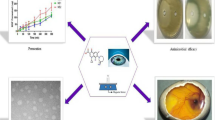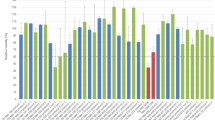Abstract
Purpose. The aim of this study was to find new biocompatible surfactants and mixtures with low ocular irritant action for application in pharmaceutical formulations and to establish a relationship between their structure and their potential ocular irritant activity.
Methods. An alternative method to the Draize in vivo test, based on the adverse effects of surfactants on the cytoplasmic membrane of red blood cell, was used to evaluate the potential ocular irritation of the surfactants.
Results. It was found that the hemolytic activity of arginine-based gemini surfactants increased with the aliphatic alkyl chain lengths of the hydrophobic tail. The addition of the surfactant with an alkyl chain length of 10 carbon atoms to cocoamidopropilbetaina (TB), decylglucoside (APG), and Nα-lauroyl-arginine ethyl ester (LAE) increases the hemolytic activity moderately for the mixtures with TB and LAE (1.1- and 1.5-fold, respectively) and strongly for APG (fivefold).
Conclusions. The new arginine-based gemini surfactants constitute a suitable alternative to commercial surfactants because of their natural origins, which make them biocompatible and renewable products. Based on their hemolytic activity as an alternative to the Draize test, these new arginine-based gemini surfactants and their mixtures can be classified as mild irritants. This fact constitutes an advantage, especially for pharmaceutical and cosmetic applications.
Similar content being viewed by others
References
M. Paulsson and K. Edsman. Controlled drug release from gels using surfactants aggregates. II Vesicles formed from mixtures of amphiphilic drugs and oppositely charged surfactants. Pharm. Res. 18:1586-1592 (2001).
P. Clapés and M. R. Infante. Amino acid-based surfactants: Enzymatic synthesis, properties and potential applications. Biocat. Biotrans 20:215-233 (2002).
R. Valivety, I. S. Gill, and E. N. Vulfson. Application of enzymes to the synthesis of amino acid-based bola and gemini surfactants. J. Surfactants Deterg 1:177-185 (1998).
J. D. Hines. Theoretical aspects of micellisation in surfactant mixtures. Curr. Op. Coll. Interf. Sci. 6:350-356 (2001).
W. J. W. Pape, U. Pfannenbecker, and U. Hoppe. Validation of the red blood cell test system as in vitro assay for the rapid screening of irritation potential of surfactants. Mol. Toxicol. 1:525-536 (1987).
J. H. Draize, G. Woodard, and H. O. Calvery. Methods for the study of irritation and toxicity of substances applied to the skin and mucous membranes. J. Pharmacol. Exp. Ther. 82:377-390 (1944).
M. Balls, P. A. Botham, L. H. Bruner, and H. Spielmann. The EC/HO international validation study on alternatives to the Draize eye irritation test. Toxicol. In Vitro 9:871-929 (1995).
A. A. Kulkarni and A. J. Hopfinger. Membrane-interaction QSAR analysis: application to the estimation of eye irritation by organic compounds. Pharm. Res. 16:1245-1253 (1999).
B. Isomaa, H. Hägerstrand, G. Paatero, and A. C. Engbliom. Permeability alterations and antihemolysis induced by amphiphiles in human erythrocytes. Biochim Biophys Acta. 860:510-524 (1986).
E. Piera, M. R. Infante, and P. Clapes. Chemo-enzymatic synthesis of arginine-based gemini surfactants. Biotechnol. Bioeng. 70:323-331 (2000).
M. R. Infante, J. Seguer, A. Pinazo, and M. P. Vinardell. Synthesis and properties of symmetrical nonionic double chain surfactants from lysine. J. Dispers. Sci. Technol. 20:621-642 (1999).
M. A. Vives, M. R. Infante, E. García, C. Selve, M. Maugras, and M. P. Vinardell. Erythrocyte hemolysis and shape changes induced by new lysine-derivate surfactants. Chemico-Biol Interact 118:1-18 (1999).
D. Liechtenberg, R. J. Robson, and E. A. Dennis. Solubilization of phospholipids by detergents: structural and kinetic aspects. Biochim. Biophys. Acta 737:285-304 (1983).
M. Macián, J. Seguer, M. R. Infante, C. Selve, and M. P. Vinardell. Preliminary studies of the toxic effects of non-ionic surfactants derived from lysine. Toxicol 106:1-9 (1996).
T. Reinhart and K. H. Bauer. Investigations about hemolysis and solubilization behaviour of nonionic polymeric surfactants. Pharmazie 50:403-407 (1995).
Author information
Authors and Affiliations
Corresponding author
Rights and permissions
About this article
Cite this article
Mitjans, M., Martínez, V., Clapés, P. et al. Low Potential Ocular Irritation of Arginine-Based Gemini Surfactants and Their Mixtures with Nonionic and Zwitterionic Surfactants. Pharm Res 20, 1697–1701 (2003). https://doi.org/10.1023/A:1026164123938
Issue Date:
DOI: https://doi.org/10.1023/A:1026164123938




